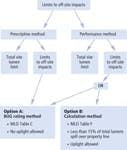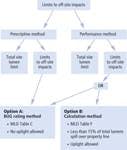This article was published in the April/May 2012 issue of LEDs Magazine.
View the Table of Contents and download the PDF file of the complete April/May 2012 issue, or view the E-zine version in your browser.
+++++
The Model Lighting Ordinance (MLO), recently published by the International Dark-Sky Association (IDA) and the Illuminating Engineering Society (IES), is designed to help municipalities develop standards for environmentally-responsible, yet safe, outdoor lighting. The guidelines for area lighting apply to businesses, property owners, and building owners. They specify light levels and allowable light pollution based on defined zones that are appropriate for different settings ranging from residential to New York's Times Square. But, the MLO offers options in terms of how light levels and pollution are characterized and today, as we will show with a case study, you can get drastically different answers as to whether a luminaire is appropriate for a given installation.
One of the main purposes of the MLO is to “minimize adverse offsite impacts of lighting such as light trespass and obtrusive light.” The MLO can be downloaded from the IDA website (http://bit.ly/iRt0Dk).
Both methods require a total site lumen limit. These limits are different depending on which method is chosen. The performance method allows anywhere from 25% to 40% more lumens per site than allowed with the prescriptive method.
The main difference is that with the prescriptive method there are no limits on foot-candle levels leaving the site; there is only a restriction to use fixtures that have allowed BUG (Backlight, Uplight and Glare) ratings.
The performance method requires that you prove spill light by following either the BUG rating method, or by providing computer calculations showing that there is no vertical illuminance on the sides of the property line and that the total lumens leaving the site do not exceed the allowed levels.
MLO options
The prescriptive method is simple; calculate the total site lumens allowed according to one of two tables (limited to hardscape areas) and choose fixtures that meet the given BUG rating restrictions.
As shown in Fig. 1, the MLO proposes two options, which are designed to aid the selection of appropriate luminaires to limit the off-site impact. The prescriptive method is referred to as option A or the BUG rating method, while the performance method is referred to as option A or option B (the calculation method).
According to the MLO, both option A and option B are capable of preventing off-site impact such as glare, sky glow and light trespass.
The BUG rating method, as described in TM-15-11 Addendum A, establishes a BUG rating for any luminaire based on a lumen limit in each secondary solid angle.
According to the MLO, in order to conform to the BUG rating method, any fixture on the site must comply with the maximum allowable BUG ratings in Tables C-1 (backlight rating), C-2 (uplight ratings) and C-3 (glare ratings) from the MLO.
The calculation method does not limit the designer’s ability to select the luminaire type or location. It just requires that computer lighting calculations show compliance with the maximum vertical illuminance at any point in the plane of property line, as shown in Table F of the MLO.
Comparing options
In an effort to verify and compare options A and B, the following comparison tests were run. Fifty-one LED and HID luminaires with distribution types 1, 2, 3 and 4 were selected for 84 installations, according to option A (BUG rating method, Table C). Some luminaires were selected for three installations for different LZ and positions, some for two and others for one only. Luminaire wattage varied from 25W to 310W for LED, and from 100W to 250W for HID.
All installations were done based on compliance with the maximum allowable BUG ratings as shown in Tables C-1, C-2 and C-3. The maximum allowable ratings are defined according to the LZ and installation position. For example, luminaires with a BUG rating of B=3, U=0, G=1 could be installed for LZ3 in positions that are a distance of 0.5 to 1.0 mounting height (mh) from the property line.
If the same luminaire is supposed to be used for LZ2, the allowed position for this luminaire is 1-2 mh from the property line.
Maximum vertical illuminance
The measurement of maximum vertical illuminance as per option B (calculation method) was done for each of the 84 luminarie installations, which were all in compliance with option A.
Fig. 2 shows the lighting layout used for the calculation of maximum vertical illuminance. The pole height was 20 ft, and the vertical grid rose 33 ft above the pole. The tested luminaire was installed in the middle of one of the three positions (1-2 mh, 0.5-1.0 mh, or less than 0.5 mh) according to MLO Table C. The actual pole spacing from the property line was designated as either 1.5, 0.75 or 0.25 mh. The total length of the testing site was 200 ft.
Table 1 provides the calculation summary for each LZ and all test summaries. A total of 84 luminaire installations were approved based on option A, but only 16 of those were able to meet the option B requirements. Therefore, only 19% of the luminaires that complied when using option A also complied with option B.
The MLO also rates luminaires that are “not ideally oriented.” In this type of installation there is an additional glare value limitation noted in MLO Table C-3.
Six luminaires (both LED and HID) were rated and installed in not-ideally-oriented positions in LZ3, at 0.5-1.0 mh to the property line. All installations complied with option A according to Table C-1, C-2 and C-3 for backlight, uplight and glare (not ideally oriented), respectively.
Discrepancies
This discrepancy between the two options is alarming. Both options should be consistent and compatible. If lighting fixtures were appropriate for the first option, all selected luminaires should have been appropriate for the second option as well, and the reverse is true.
All previous tests have been done for single luminaires installed on a 200-ft-long test site. In real practice, more than one pole would be used for lighting design, sometimes with two or more luminaires per pole. In a real situation, every luminaire would contribute to the off-site impact of lighting. The BUG rating system is not capable of accounting for the effect of a multiple-luminaire installation. The comparison between the BUG rating method and the calculation method would be even worse in the case of an actual site installation.
The MLO has a purpose of limiting spill light and offers two options to meet this goal. As is shown by the comparisons run, the calculation method (option B) is much more effective at meeting this goal. However, the BUG rating method (option A) is easier to use and not as restrictive on spill light, therefore many sites will default to the BUG rating method for ease of use.
From these examples, it is apparent that the BUG rating method (option A) and calculation method (option B) are not equal at limiting light leaving the site. The prescriptive method is more restrictive regarding the total site lumens; however, it allows for a greater amount of spill light because it is solely based on the BUG rating method from Table C.
The MLO allows for the use of BUG ratings along with the performance method as long as there is no uplight used. This scenario would not only allow for more lumens on the site as compared to the prescriptive method, but also would allow for a greater amount of light spilling from the site than would be seen from sites that restrict the spill by using the calculation method. As proven from the studies done for this article, the BUG rating method cannot effectively control these extra lumens of spill light.
If the objective is to put the best lighting on the site and limit light leaving the site, then option B using the calculation method is by far the most effective means of limiting light trespass.










